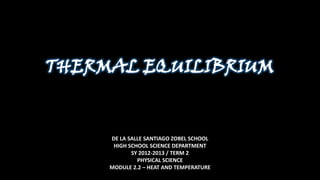
Calorimetry and methods of mixtures
- 1. THERMAL EQUILIBRIUM DE LA SALLE SANTIAGO ZOBEL SCHOOL HIGH SCHOOL SCIENCE DEPARTMENT SY 2012-2013 / TERM 2 PHYSICAL SCIENCE MODULE 2.2 – HEAT AND TEMPERATURE
- 2. Lesson Objectives: Recall how heat transfer happens; Define thermal equilibrium; Explain how the law of conservation of energy applies to heat transfer,; and objects in thermal equilibrium; and Systematically solve problems on calorimetry and methods of mixtures by applying the formula of the law of conservation of energy in thermal systems.
- 3. Objects in “Thermal Contact” If you mix cold milk with hot coffee, Will heat transfer happen within the milk-coffee mixture? Why? What will be the direction of heat flow? Why? After some time, what do you think will happen to the temperature of the milk-coffee mixture?
- 4. Thermal Equilibrium the condition when objects in thermal contact achieve a common final temperature in this state, no NET heat Object A Object B transfer happens between the two objects in thermal contact the sum of all heat gained and heat lost in the thermal system is equal to zero
- 5. The Law of Conservation of Energy “Energy can neither be created nor destroyed.” or In a thermal system, this law applies such that no heat (energy) is created nor destroyed. or Therefore, all heat gained should balance all heat lost in a thermal system.
- 6. Objects in Thermal Equilibrium When objects achieve the state of thermal equilibrium, the formula of the law of conservation of energy in thermal systems can be used to solve for the common final temperature of the system and other involved variables. Note that the formula is just the same as
- 7. Sample Problem A 100 oC nickel coin with a mass of 10-g is immersed in a 50-g glass of water at 20 oC. The specific heat of nickel is 0.44 J/g oC while water’s specific heat is 4.18 J/g oC. What is the final temperature of the system when it achieves thermal equilibrium?
